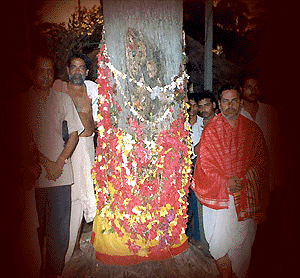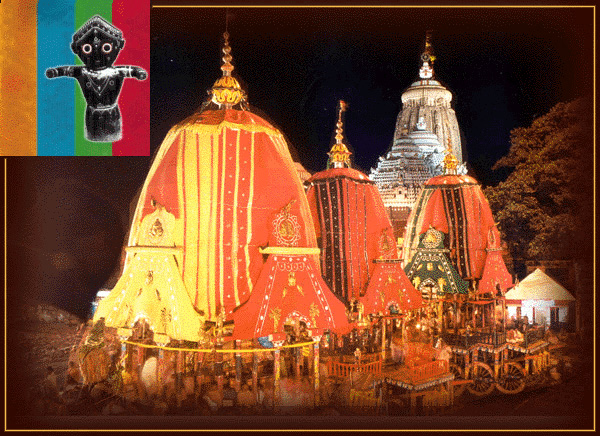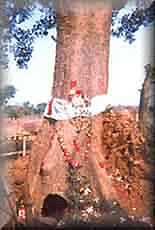Navakalevara of Lord Jagannatha
BY: SUN STAFF

Daru of Devi Subhadra in Navakalebar
Mar 4, CANADA (SUN) — While the Ratha Yatra at Jagannatha Puri is one of the most well known festivals in all of Orissa, the importance of the chariot festival increases when it is held in conjunction with the Navakalevara ritual. The term Navakalevara means "new body" ('nava' means new and 'kalevara' means body). During the Navakalevara ceremony the old figures of Lord Jagannath, Balabhadra and Shubhadra are replaced with new ones. The bodies of the Deities are made of neem (margosa) wood, which is acquired according to strict rules.
The Deity form of Lord Jagannath shelters the transcendental Brahma Padartha (Supreme Matter) and is therefore known as Daru Brahma. During Navakalevara, this Daru Brahma (prime-soul enshrined in wood) of Lord Jagannath is also transferred from the old figure to the new one.
While Buddhists describe the Brahma Padartha as being the tooth of Buddha, Vaisnavas understand it to be the live Salagrama. According to the Shabaras people, Zara Shabara pierced the feet of Sri Krsna at Mahendragiri with an arrow, thereby causing His death. Arjuna instructed the crying Zara to cremate the body, but Zara could not bear to burn Krishna's body completely. The navel portion remained unburned, and was kept inside the initial Deity form worshipped by the tribals as Nilamadhava. This element is transferred from old Deities to new ones in the dead hour of the night by a hereditary sevayat (servant) of the temple. The sevayat is completely blindfolded, and his hands and feet are wrapped with thick layers of silk ribbons so that he can neither see nor feel anything about the element being transferred.

Years which have two lunar months of Ashadha are regarded as auspicious times for the Navakalevara ceremony to be held. Such dates this occur once in every 12 years, but not strictly so. They may also occur in 16 or 19-year cycles. The last four Navakalevara ceremonies for Their Lordships were celebrated in these years: 1733, 1744, 1752, 1771, 1790, 1809, 1828, 1836, 1855, 1874, 1893, 1912, 1931, 1950, 1969, 1977 and 1996. On these occasions, countless throngs of devotees make their way to Jagannatha Puri in order to be present for this ecstatic event.
Navakalevara activity begins in the month of Chaitra, shukla dasami. Nobody knows in advance where the sacred wood will be found to create the new Deity forms. According to tradition, the priests of Jagannatha Temple travel to Kakatpur, which is 80 km. Northeast of Puri. After taking bath in the River Prachi they pray to the Goddess Mangala, who is the presiding Deity of Kakatpur, asking her to help them find the sacred wood. The priests then sleep in front of the Goddess with their face down (locally known as adhia posture) and the Goddess Mangala comes in their dreams to tell them of the exact locations of the sacred neem trees for all the Deities. This Navakalevara custom has been performed for many years, without deviation.

The priests then travel on foot to the locations given in their dreams. They locate the correct trees by identifying all the prerequisite signs, which qualify the sacred tree for the Deities. These prerequisites include the following:
1. They must have a wheel (chakra) sign on them
2. Poisonous snakes like the Cobra must be hiding under them or in a nearby ant hill
3. A tamarind tree must be in the vicinity
4. A funeral yard must be in the vicinity of each tree
5. Each tree must have 4 to 7 branches over the main trunk
6. From ground level up to 10-12 feet, the trunk should be straight and solid
7. There must be no nest of birds on the treetops
After predefined rituals are performed, the trees are cut. A small cart with four wheels is then constructed from the smaller branches of each of the trees, and the main trunks of the trees are thereby transported on the carts to Jagannatha Puri. The cart is pulled all the way by the devotees of the villages it passes through.
After reaching Puri, the wood enters the Jagannatha Temple through its northern gate, just before the scheduled date of the annual bathing ceremony of the Deities (Devasnana Purnima). On the next day after the bathing ceremony, the Deities are carved out of the trunks, in secrecy and according to the proscribed specifications. The work is done at a specified place inside the temple premises, known as Koili Baikuntha.
Before Asadha Chaturthy night the new Deities are completed. On this night during the midnight hours, the Brahma Padarth (the Supreme Matter) is transferred from the old to new Deities.
The following table provides the details of the places from where the sacred neem trees were found for the Deities in each of the previous Navakalevaras:

